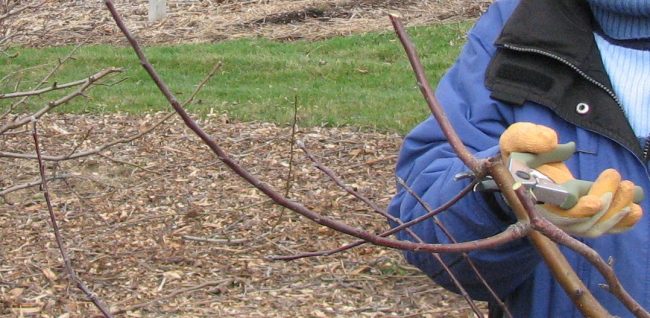By Vijai Pandian

Late winter is the time to start pruning your fruit trees. Start pruning before new growth appears on the branches.
Late winter is an excellent time to prune backyard apple trees. Pruning opens up the dense canopy and allows better air movement, light penetration, reduces pest and disease pressure, and enhances fruit quality. The height of the tree can also be reduced for easy access during the harvest period and for better spray coverage. Schedule your pruning when the weather is sunny and the temperature is above freezing. The cutoff date to prune fruit trees is before the bud break when new green growth appears on the branches.
For a live demonstration on how to prune trees, join us for an outdoor apple pruning class on March 16th, 5.00 P.M. at the Kenosha County Center, 19600 75th Street, Bristol WI 53104. This program is open to the public and is free of cost. No pre-registration is required. Dress according to the weather.
If you are not able to make the class read-on for tips on keeping your apple trees healthy.
Tips for Pruning Apple Trees:
Before you attempt to prune fruit trees, disinfect the pruning tools with 70% rubbing alcohol or Lysol solution. Pruning tools need to be sharp and clean. Pruning paint is not needed to dress the wounds.
What to prune in a young apple tree:
- Remove any dead, diseased, or broken branches to its point of attachment.
- Remove any water sprouts that compete with the trunk and other main branches for light. Water sprouts are vigorous, upright shoots that are formed on the scaffold branches (main branches), lateral branches, and also grows at the cut ends from last year’s pruning. If needed, you can leave a few water sprouts on the outer branches to fill in any open spots in the canopy area.
- Prune off all the suckers that grow from the base of the tree.
- Branches that are crisscrossing over other branches or growing parallel to each other can be removed.
- Perform a heading cut (pruning back to a bud or a larger branch) or if necessary, remove any long growing branches or limbs that shade out the lower branches. In apple trees, the lower branches need to be wider than the upper branches for better light distribution to all branches.
- When pruning large branches, make a smooth and close cut to the branch collar region. Don’t leave a stub.
- After pruning, disinfect the pruning tool again with 70% rubbing alcohol or Lysol solution to prevent any spread of diseases.
Young apples need to be trained in the early stage of their life. The young branches of the tree are positioned to form a 60-degree crotch angle from the leader using techniques like a clothespin spreader, tying with strings, and positioning weights on the branches. Mature branches are trained by using a wooden spreader with a notch at its end.
To learn more about the pruning and training techniques, view our Extension Publication on “Training and Pruning Apple Trees” online at learningstore.extension.wisc.edu. You can view a PDF version of the publication for free, or purchase a hard copy to be delivered through the mail.



